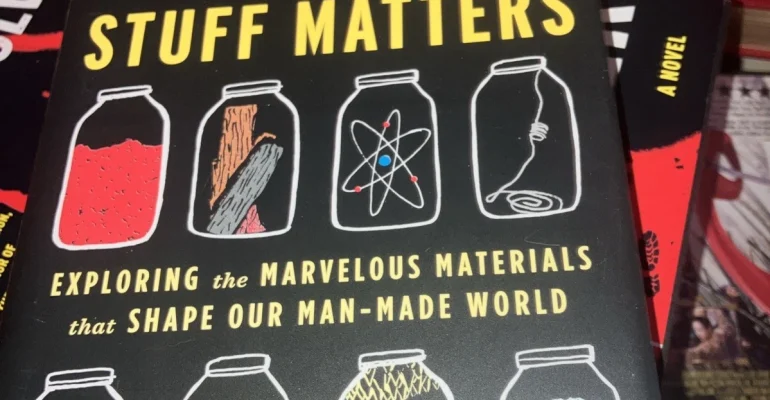Book Review - ”Stuff Matters” by Mark Miodownik
Every once in a while, a book comes along that changes the way you see the world, not by adding anything to it, but by revealing what’s already there. Mark Miodownik’s “Stuff Matters: Exploring the Marvelous Materials That Shape Our Man-Made World” is one of those rare delights: a slim 220-page invitation to rethink the ordinary. A professor of Materials & Society at University College London, Miodownik brings to life the secret stories of the stuff that quite literally holds our world together: glass, steel, chocolate, paper, plastic, and even concrete.
Reading it, one would see that it’s part science book, part love letter. Whether he’s geeking out over the secret of Samurai swords or meditating on the flavorlessness of stainless steel cutlery, Miodownik blends scientific rigor with the joyful curiosity of a child in a chemistry lab. The guy loves this stuff, and it’s infectious how he loves what he does for a living. And he does not shy away from making the reader realize and silently acknowledge that the materials we take for granted are tiny miracles of human ingenuity and natural wonder.
“We are one of the first generations who have not had to taste our cutlery,” he writes, marveling at stainless steel. “It’s the transparent protective layer of chromium oxide that makes the spoon tasteless, since your tongue never actually touches the metal and your saliva cannot react with it.”
The book begins, unassumingly enough, with a photograph of the author drinking tea on a rooftop. Around him: steel rails, concrete walls, paper books, ceramic cups, glass windows. From there, Stuff Matters unspools into a quiet epic of elements, processes, and chance discoveries.
Take steel, for instance. We learn that Samurai swords weren’t just weapons, they were metallurgical masterpieces, engineered at a molecular level for maximum flexibility and sharpness. Then came Henry Bessemer, whose bombastic self-confidence led him to create a system of making industrial-scale steel that even surpassed those legendary blades. And yet, it was the accidental discovery of stainless steel by Harry Brearley, aiming to solve gun barrel corrosion, that gave us modern cutlery.
This is Miodownik’s trademark move: turning what could be dry science into drama, full of characters, conflict, and quirk.
“We may like to think of ourselves as civilized,” he says. “But that civilization is in large part bestowed by material wealth.”
He’s equally poetic when writing about glass. The East, he explains, never developed a deep affinity for it, favoring paper windows. That cultural choice might have shaped history itself.
“The lack of glass technology in the East meant that, despite their technical sophistication, they never invented the telescope nor the microscope… and had access to neither until Western missionaries introduced them.”
In a single paragraph, Miodownik connects architectural preferences to the absence of a scientific revolution. It’s a sobering reminder that materials don’t just reflect culture, they steer it.
Even the chapter on chocolate, which the author clearly enjoyed more than I did (as someone with no real history with chocolate, either as a kid or adult), manages to astonish. Did you know chocolate contains a psychoactive stimulant called theobromine? It’s a cousin of caffeine, and fatally toxic to dogs. Every Easter and Christmas, many dogs die after indulging in the festive sweet. That blend of delight and danger is a recurring motif in the book.
Then there’s aerogel: a ghostly, translucent substance that looks like smoke made solid.
“Most people will never hold a piece of aerogel in their hand, but those who do never forget it,” Miodownik writes.
It’s a material lighter than air, strong as metal, and almost otherworldly in appearance, a true feat of human craftsmanship.
And let’s not forget diamonds, those chemically mundane yet culturally exalted chunks of carbon. Miodownik deflates the myth with glee, describing the “Diamonds Are Forever” campaign as one of the most successful marketing gimmicks in history. Then he delivers a knockout fact:
“The biggest diamond yet discovered is located in the Milky Way… an entire planet five times the size of Earth.”
How mind-boggling is that!
What struck me most was how Stuff Matters transformed my perception. Sand is no longer just sand; it’s the beginning of glass, of skyscrapers, of fiber optics. Paper is not just a medium, but a marvel. And gold? It’s not merely precious, it’s soft and totally impractical as a pure ring metal because it scratches too easily. No wonder it’s often alloyed with harder elements to withstand the wear of time.
Even concrete, which gets so much hate in the west, gets its due. As Miodownik reveals, the concrete jungle is a human achievement on par with any ancient wonder.
This wasn’t just a book I read once; I read it twice, and still felt like I’d only skimmed the surface. It was first recommended to me by an AI chatbot when I asked for a chemistry book that wouldn’t bore me to death. I’m glad I took the advice. What I got was not only chemistry, but history, physics, ingenuity, and wonder, bound into a single, compelling volume.
Stuff Matters doesn’t just explain materials, it makes you feel something about them. It reminds us that science isn’t just in laboratories; it’s in the walls we build, the tools we use, the spoons we eat with, and the glass we gaze through.
Enlightening and brimming with tactile wonder, Stuff Matters is a hymn to the hidden marvels of the material world, and to the incredible power of the human minds that shape them.


